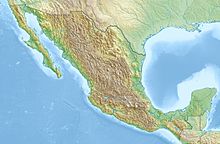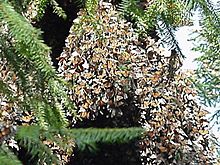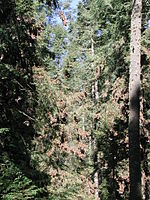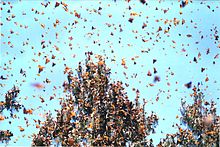- Monarch Butterfly Biosphere Reserve
-
Coordinates: 19°36′23″N 100°14′30″W / 19.60639°N 100.24167°W
Monarch Butterfly Biosphere Reserve * UNESCO World Heritage Site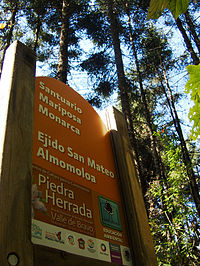
Entrance of Monarch Butterfly Biosphere ReserveCountry Mexico Type Natural Criteria vii Reference 1290 Region ** Latin America and the Caribbean Inscription history Inscription 2008 (32nd Session) * Name as inscribed on World Heritage List
** Region as classified by UNESCOThe Monarch Butterfly Biosphere Reserve is a conservation area and World Heritage Site within the wintering grounds of most of the monarch butterflies that migrate from east of the Rocky Mountains for up to 4,000 km south to central Mexico. The reserve is located in the Trans-Mexican Volcanic Belt pine-oak forests ecoregion on the border of Michoacán and Mexico State, 100 km northwest of Mexico City. It is estimated that between 60 million and 1 billion butterflies arrive in this area alone any given year. While over 56,000 hectares are part of the biosphere reserve, the butterflies themselves only inhabit a fraction of this when they are in Mexico from October to March. The biosphere’s mission is not only to protect the butterfly species, but also to protect the ecosystem of which it is a part.
This area, which hosts the majority of wintering monarchs from the east of the United States and Canada, has only been known to scientists since the 1970s. Protection of the area began with a series of presidential decrees in the 1980s, and a 2000 decree promoted the area to the status of federal biosphere reserve. In 2008, the Reserve was inscribed on the list of World Heritage Sites. Although the montane site remains predominantly rural, a number of conservationists are concerned about the deleterious effects of illegal logging, growing tourism, and tensions between conservation authorities and communities inhabiting the land upon which the Reserve was established[1][2]
Contents
Monarch migration
The monarch butterfly is noted for their lengthy annual migration. It is the only butterfly species known to make annual north-south migrations like many bird species do. Monarchs in North America roughly divided into two migrations. Those in the west tend to migrate toward California for the winter and those east of the Rocky Mountains migrate south. However, no single individual makes the entire round trip, as butterfly lifespans vary from just two months to about seven months for those who hibernate[3] It is not clear how these monarchs know how to return to the same wintering sites as their ancestors, but flight patterns seem to be inherited.[4][5]
Wintering sites for these eastern butterflies are thought to be as far north as Texas and Oklahoma .[6] However, most travel south into Mexico, crossing the border south from Texas and then following the Sierra Madre Oriental mountains.[7] After thirty years of studying the migrations of eastern monarchs, zoologist Freud Urquhart discovered in 1975 the site where the butterflies migrate to. They spend the winter in the forests of pine and oyamel fir in central Mexico, along the border of the states of Michoacán and Mexico. For those who come from the U.S./Canadian border area, this represents a voyage of about 4,000 km.[8] This southward migration concentrates a large number of insects from a widely dispersed area in the north to a small area in the south. This kind of migration is unique in the world.[9][10] These butterflies spend about five months in this area of Mexico, arriving in October and leaving in March.[8]
It is estimated that anywhere from 60 million to a billion butterflies arrive to the central Mexican highlands every winter, mostly clustering in the small area along the border of the states of Michoacán and Mexico.[8][9] These butterflies congregate into colonies, clustering onto the pine and oyamel trees. In many cases, they are so thick that the trees turn orange in color and branches sag from the weight.[9][11] When these butterflies take flight for mating purposes, they can fill the sky and appear like clouds and the beating of their collective wings has been compared to light rain.[9][12] Although these forests are located in central Mexico, their altitude makes the area susceptible to low and freezing temperatures at night. If the weather gets too cold, the butterflies will die. Low temperatures at night each year kill a certain percentage every year, usually the weakest. However, unusually cold winters, such as the one that occurred in 1996/1997, can kill off so many that their bodies cover the ground. However, not all butterflies that fall to the ground overnight are dead. Some will reanimate when the sun rises in the morning. One reason the butterflies congregate so thickly on trees is to conserve heat. At dawn, the butterflies will open their wings to catch the sun’s warming rays. When the temperatures get warm enough in the daytime, the butterflies will rise up into the air en masse for mating.[13]
History of the area
In the pre-Hispanic period, this area was occupied by the Otomi. There was one major settlement near the Coatepec Mountain, which is now the archeological zone of San Felipe los Alzati. This settlement is considered to have been on the cultural frontier of the P'urhépecha Empire. Since then, the area has been important for mining and farming, but it has remained mostly rural, with significant communities of Otomi and Mazahua, especially on the Mexico State side.[10]
In 1975, this area’s importance to the monarch butterflies of the eastern U.S. and Canada was discovered by zoologist Freut Urquhart.[8] The area was decreed a protected zone in 1980 as a wildlife refuge by President José López Portillo. In the latter part of the decade, management of the area passed into the hands of Secretariat of Urban Development and Ecology, which assigned it the category of “special biosphere reserve.” In 1986, a federal decree exactly defined the area and boundaries of the zones protected.[10] In 2000, its name of Monarch Butterfly Biosphere Reserve (Reserva de la Biosfera Mariposa Monarca) was given by another federal decree.[8][14] Initial conservation efforts in the 1980s focused only on the direct welfare of the monarch butterfly. Since then, research and other efforts have focused on preserving the ecosystems that the butterflies are part of.(mediaambiente) Other efforts have worked with local communities to help them participate in conservation efforts and find ways to make a living without harming the butterfly habitats.[15] While the federal government proclaimed these areas as biosphere reserve, legal title has not changed. Most of it is divided among 38 ejidos, seven indigenous communities and 16 private holdings.[10] UNESCO declared the biosphere a World Heritage site in 2008 as a Natural Asset. This declaration was added to that which made San Miguel de Allende a World Heritage Site.[14]
Ecosystem
The wintering areas of the butterfly are located on the mountainous forests that stretch across far eastern Michoacán state and far western Mexico State, about 100 km northwest of Mexico City.[10][11] The area on the Michoacán side consists of the highest elevations of the state, including peaks that reach 2,700 masl. The climate of the region is classed as C(w2)(w)(b’(i"); or temperate and somewhat moist with a rainy season in the summer. Average maximum temperature is 22C with variance between 5 and 7 degrees. Altitude divides the region into three sub climates (cool and semi moist, semi cold and semi moist and cold and semi moist) .[10]
The area is part of the Trans-Mexican Volcanic Belt and much of its terrain is due to outcroppings of basalt that formed fissures, faults and cliffs with a northeast-southwest orientation. These rock formations cover older ones such as volcanic cones and old lava beds. This area is highly permeable, so there is little surface water except for small ponds and arroyos.[10][15] These mountains are mostly covered in forests which vary by altitude and region: holm oak up to 2900masl, holm oak and pine between 1500 and 3000 masl and oyamel fir between 2400 and 3600masl. There are also small areas with junipers, cedars and meadows. Areas below 2400 have mostly been drastically modified due to agriculture and human settlements. The most important areas to the monarch are the forests of pine and oyamel fir trees as these areas provide microclimates that provide shelter when overall temperatures fall to freezing or when there are winter rains.[15]
The wildlife in the area ranges from the sub-tropical to the sub-arctic including a number of species that are endemic only to this area. These include white-tailed deer (Odocoileus virginianus), coyotes (Canis latrans), long-tailed weasels (Mustela frenata), grey foxes (Urocyon cinereoargenteus), rabbits (Sylvilagus spp.), crows (Corvus corax), turkey buzzards (Cathartes aura), horned owls (Bubo virginianus)(A), as well as various types of hummingbirds, reptiles and amphibians.[10]
Monarch colonies
There are fourteen major butterfly colonies located in these rugged forested mountains, which account for more than half of colonies of the monarch butterfly’s eastern U.S./Canada population. It is estimated that up to a billion individuals spend winter here in any given year.[9] These colonies are dense, with between six and sixty million butterflies per hectare.[12] The reserve areas are found in the municipalities of Ocampo, Angangueo, Zitácuaro and Contepec in Michoacán and Donato Guerra, Villa de Allende and Temascalcingo in the State of Mexico. They are divided into five principal zones or nuclei.[10]
Eight of the fourteen colonies are in the protected area.[9] The colonies proper cover only 4.7 hectares,[12] but the protected biosphere area covers 56,259 hectares.[9][11] Four colonies are open to visitors: Sierra Chincua and El Rosario in Michoacan, and La Mesa and El Capulin in the State of Mexico. There are other colonies near San José Villa de Allende and Ixtapan del Oro, but they are not actively promoted for tourism because of the risk of harm to these butterfly colonies.[16] El Rosario is the largest sanctuary in Michoacán, where the butterflies cover about 1,500 trees.[13]
While the Biosphere still has problems with infrastructure, most notably with trash (especially around parking and merchant areas), a number of improvements have been recently made, most notably in the sanctuary of El Rosario. These include well-defined footpaths with security patrols and stone/or concrete steps in steep places to help against erosion. Horsepaths were also eliminated for erosion reasons.[17] Only two areas have significant installations. In the Sierra Chincua there is a research facility dedicated to the monarch butterfly and a nursery for reforestation efforts. At Cerro El Companario there are facilities for tourism.[10]
Tourism
Five of the eight colonies are located in Michoacán but only two are open to the public: Sierra Chincua in Angangueo and El Rosario in Ocampo. Both receive visitors starting from November until March. They offer guided tours.[8] In the State of Mexico, La Mesa and El Capulin are open to the public.[16] These reserves are visited by thousands of Mexican and international tourists, principally from the United States, Canada, Spain, France, Germany and Japan.[13] The best known and most visited of the butterfly colonies is El Rosario.[12]
In February, Anguangueo celebrates its Festival de la Mariposa Monarca (Monarch Butterfly Festival) .[18] This festival began in 1992 to promote awareness of the butterfly habitat, take advantage of the ecotourism it offers and promote the culture and arts of the area. The festival includes events related to food, music, dance and exhibitions of arts, crafts and more. Many of the surrounding communities participate including Aporo, Contepec, Hidalgo, Irimbo, Jungapeo, Maravatío, Ocampo, Senguio, Tuxpan, Tlalpujahua and Zitácuaro.[19] In 2010, the festival included the participation of the Symphonic Orchestra of Michoacan, The Enrico Caruso Ensemble, and the showing of an exhibition called "Papaloapan" about the monarchs by visual artist Luis Moro, as well as dance and photography workshops. These events took place at venues in Anguangeo and other nearby communities.[20]
Conservation
The survival of the species depends on a large number of habitats from Canada, the United States and Mexico during its annual migration cycle. The three countries adopted a plan in 2008 for the conservation of the butterfly’s habitat through its migration routes.[6] Within the Biosphere in Mexico, the greatest threats to the butterfly habitat are deforestation, illegal logging, unorganized tourism, forest fires and lack of cooperation among various authorities.[10][15] Most of these dangers come from the surrounding human settlements, which put pressure on the natural areas to provide agricultural space and forestry products such as fuel and wood for manufacturing furniture and other crafts. The main human communities in the area are Contepec, Temascalcingo, Angangueo, Ocampo, San Felipe del Progreso, Zitácuaro, Villa de Allende and Donato Guerra. The closest urban center is Zitácuaro, whose growth has promoted the growth of the other, more rural settlements.[10]
In spite of this, most of the area is still occupied by dispersed rural farming communities of Otomi and Mazahua peoples, especially on the Mexico State side.[10][15] Many of the protected hectares do not belong to the government directly, rather they are lands divided among 59 ejidos, thirteen indigenous communities and 21 individual holdings. Because of this and the fact that the reserve is divided by a state line, conservation efforts are complicated. Many communities in this region are very poor, with high illiteracy rates and childhood malnutrition, with scarce access to basic services. In the past, mining provided much of the area’s jobs but mines have since been depleted and most live on subsistence agriculture. These communities also have a tradition of exploiting forest areas, mostly to obtain wood for furniture making and other crafts. High unemployment, especially for youth, also provoke migration out into other parts of Mexico and to the United States or Canada.[15]
Most of the butterfly colony areas still host economic activities such as subsistence farming and livestock raising. In some areas, such as Sierra Chincua, Cerro Pelon and El Rosario, there are still problems with illegal logging to supply local fuel needs as well as for raw materials for handicrafts.[10][13] El Rosario is named after the local ejido which belongs to about 10,000 “campesinos” or rural farmers. Many of these people make a living through farming and the sale of handcrafts and foods to tourists.[13] Information about the butterflies is insufficient as it is not know the full extent of their wintering areas, nor the ecology of the area. Because of this, it is not known how large the reserve really needs to be for the preservation of the butterfly.[10]
Conservation is mostly done through restrictions on the lands but the management of the reserve has not had direct participation by the communities affected by it.[10][15] Some public and private entities have worked with communities to develop incentives to conserve forests and take advantage of the tourism that the butterflies bring. However, success in this has been spotty.[15] Some communities are pushing back against the restrictions and demanding to be allowed to use more land for agriculture.[13]
Since conservation efforts began, there has been progress. While infrastructure is still lacking, advances have been made in areas such as trash control and control of access into the protected areas.[12] One effort by the World Wildlife Fund has been the coordination of international biologists and ecologists to improve the design of the reserve.[15] A permanent monitoring system has been established to ensure the forests remain healthy and control clandestine logging and forest fires. On the Mexico State side, the largest sanctuary is located between San José Villa de Allende and Ixtapan del Oro. It is not actively promoted for tourism to keep damage to the area to a minimum.(StateMex) During winter 2008-2009, there are plans to tag as many of the wintering butterflies as possible using very light self-stick tracers as to not impede their flight. The purpose of this is to determine the butterflies exact migration route as they fly back north to the U.S. and Canada in the spring.[17] Butterfly counts coming in from the United States and Canada in recent years were relatively stable in the 2000s, with a dozen confirmed colonies as of the 2007-2008 winter. Colonies number varies; in 2004/2005 there were only seven. In general, the number of colonies varies between eight and twelve.[12]
See also
References
- ^ Ramírez, Maria Isabel; Azcárate, Joaquín G.; Luna, Laura (April 2002). "Effects of human activities on Monarch Butterfly habitat in protected mountain forests, Mexico". Forestry Chronicle (Canadian Institute of Forestry) 79 (2): 242–246. doi:10.5558/tfc79242-2. http://pubs.cif-ifc.org/doi/abs/10.5558/tfc79242-2. Retrieved 2011-05-25.
- ^ Tucker, Catherine (2004). "Community Institutions and Forest Management in Mexico's Monarch Butterfly Reserve". Society and Natural Resources (Routledge) 17 (7): 569–587. doi:10.1080/08941920490466143. ISSN 1521-0723. http://search.ebscohost.com/login.aspx%3Fdirect%3Dtrue%26db%3Daph%26AN%3D13775154%26site%3Dehost-live. Retrieved 2011-05-25.
- ^ Pyle, Robert Michael, "National Audubon Society Field Guide to North American Butterflies", p712-713, Alfred A. Knopf, New York, ISBN 0-394-51914-0
- ^ Merlin C, Gegear RJ, Reppert SM. (2009). Antennal Circadian Clocks Coordinate Sun Compass Orientation in Migratory Monarch Butterflies. Science 325: 1700-1704. doi:10.1126/science.1176221 PMID 19779201
- ^ Kyriacou CP. (2009). Unraveling Traveling. Science 325:1629-1630 doi:10.1126/science.1178935 PMID 19779177
- ^ a b Jorge Olmedo (July 1, 2008). "Peligro constante para las mariposas monarca [Constant danger for monarch butterflies]" (in Spanish). El Sol de México (Mexico City). http://www.oem.com.mx/laprensa/notas/n753578.htm. Retrieved December 19, 2010.
- ^ Quinatanar Hinojosa, Beatriz, ed (2009). "Mexico Desconcido Guia a Michoacan" (in Spanish). Mexico Desconocido (Mexico City: Impresiones Aereas SA de CV): 17. ISSN 9397 1870 9397.
- ^ a b c d e f Sanchez Reyna, Ramon (2008) (in Spanish). Turiguía:Michoacán [Tour Guide: Michoacán]. Mexico City: Grupo Azabache, S.A. de C.V.. p. 152. ISBN 978 6077 568 087.
- ^ a b c d e f g [Heritage Convention http://whc.unesco.org/en/list/1290 "Monarch Butterfly Biosphere Reserve World"]. UNESCO. Heritage Convention http://whc.unesco.org/en/list/1290. Retrieved December 19, 2010.
- ^ a b c d e f g h i j k l m n o p "Reserva Especial de la Biosfera Mariposa Monarca [Monarch Butterfly Biosphere Special Reserve]" (in Spanish). Mexico: Secretaría de Medio Ambiente, Recursos Naturales y Pesca, Instituto Nacional de Ecología, Comisión Nacional para el Conocimiento y Uso de la Biodiversidad. November 15, 2007. http://www2.ine.gob.mx/publicaciones/libros/2/monarca.html. Retrieved December 19, 2010.
- ^ a b c "Reserva de Biosfera de la Mariposa Monarca [Monarch Butterfly Biosphere Reserve]" (in Spanish). Mexico: CONACULTA. http://sic.conaculta.gob.mx/ficha.php?table=patrimonio_humanidad&table_id=33&estado_id=16. Retrieved December 19, 2010.
- ^ a b c d e f "Últimas noticias de la Reserva de la Biosfera Mariposa Monarca [Latest news fom the Monarch Butterfly Biosphere Reserve]" (in Spanish). Mexico City: Mexico Desconocido magazine. http://www.mexicodesconocido.com.mx/ultimas-noticias-de-la-reserva-de-la-biosfera-mariposa-monarca.html. Retrieved December 19, 2010.
- ^ a b c d e f Alfredo Granciano (January 2, 1996). "Las monarcas no soportan las bajas temperaturas y caen congeladas sobre la nieve en el refugio El Rosarió, Michoacán. [The monarchs cannot handle low temperatures and fall frozen on the snow in the refuge of El Rosario, Michoacan]" (in Spanish). Morelia, Mexico: Universidad Michoacana de San Nicolás de Hidalgo. http://www.umich.mx/mich/monarca/nevada.html. Retrieved December 19, 2010.
- ^ a b Jesús Guevara Morín (July 7, 2008). "Declara UNESCO reserva de Mariposa Monarca como Patrimonio Mundial [UNESCO declares Monarch Butterfly Reserve as World Heritage Site]" (in Spanish). El Universal (Mexico City). http://www.eluniversal.com.mx/notas/520778.html. Retrieved December 19, 2010.
- ^ a b c d e f g h i "Región Mariposa Monarca [Monarch Butterfly Region]" (in Spanish). Mexico: World Wildlife Fund Mexico. 2007. http://wwf.org.mx/wwfmex/prog_bosques_fs_mm.php. Retrieved December 19, 2010.
- ^ a b Novo, Gerardo; Jorge de la Luz (2002). The State of Mexico. Mexico City: Ediciones Nueva Guia. pp. 88. ISBN 968 5437 26 2.
- ^ a b Romo, Luis (April 2008). "Ultimas noticias de la Reserva a la Biosfera Mariposa Monarca". México Desconocido 374: 24–29. http://www.mexicodesconocido.com.mx.
- ^ "ANGANGUEO EN LA VIDA DE LA MARIPOSA MONARCA. [Angangueo in the life of the Monarch Butterfly]" (in Spanish). Morelia, Mexico: Universidad Michoacana de San Nicolás de Hidalgo. 2000. http://www.umich.mx/mich/monarca/mon-angangueo.html. Retrieved December 19, 2010.
- ^ "XVIII Festival Cultural De La Mariposa Monarca [XVIII Cultural Festival of the Monarch Butterfly]" (in Spanish). Michoacán: Secretaria de Turismo de Michoacan. http://www.turismomichoacan.gob.mx/d_evento.php?id_evento=299. Retrieved December 19, 2010.
- ^ "Festival de la Mariposa Monarca no será cancelado y apoyará a damnificados [Monarch Butterfly Festival will not be cancelled and will support victims (of flooding)]" (in Spanish). La Cronica de Hoy. Notimex en Morelia (Mexico City). March 4, 2010. http://www.cronica.com.mx/nota.php?id_nota=491867. Retrieved December 19, 2010.
World Heritage Sites in Mexico North West Archaeological Zone of Paquimé, Casas Grandes · Islands and Protected Areas of the Gulf of California1 · Rock Paintings of Sierra de San Francisco · Whale Sanctuary of El Vizcaino
North Central Franciscan Missions in the Sierra Gorda of Querétaro · Historic Centre of Zacatecas · Historic Monuments Zone of Querétaro · Historic Town of Guanajuato and Adjacent Mines · Protected town of San Miguel and the Sanctuary of Jesús Nazareno de Atotonilco
West Agave Landscape and Ancient Industrial Facilities of Tequila · Historic Centre of Morelia · Hospicio Cabañas, Guadalajara · Islands and Protected Areas of the Gulf of California1 · Monarch Butterfly Biosphere Reserve1 ·
East Earliest 16th-Century Monasteries on the slopes of Popocatépetl1 · Pre-Hispanic City of El Tajín · Historic Centre of Puebla · Historic Monuments Zone of Tlacotalpan
South West Historic Centre of Oaxaca and Archaeological Site of Monte Albán · Pre-Hispanic City and National Park of Palenque ·
South Central Archaeological Monuments Zone of Xochicalco · Central University City Campus of the UNAM · Earliest 16th-Century Monasteries on the slopes of Popocatépetl1 · Historic Centres of Mexico City and Xochimilco · Luis Barragán House and Studio · Monarch Butterfly Biosphere Reserve1 · Pre-Hispanic City of Teotihuacán
South East Ancient Maya City of Calakmul, Campeche · Historic Fortified Town of Campeche · Pre-Hispanic City of Chichén Itzá · Sian Ka'an · Pre-Hispanic Town of Uxmal
1 Shared with other region/s Categories:- Parks in Mexico
- Natural history of Michoacán
- Natural history of the State of Mexico
- Biosphere reserves of Mexico
- World Heritage Sites in Mexico
- Visitor attractions in Mexico
- Butterflies and moths of North America
- Trans-Mexican Volcanic Belt
Wikimedia Foundation. 2010.

